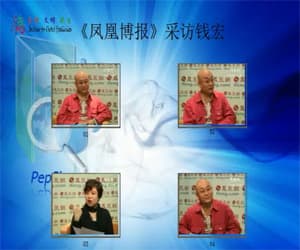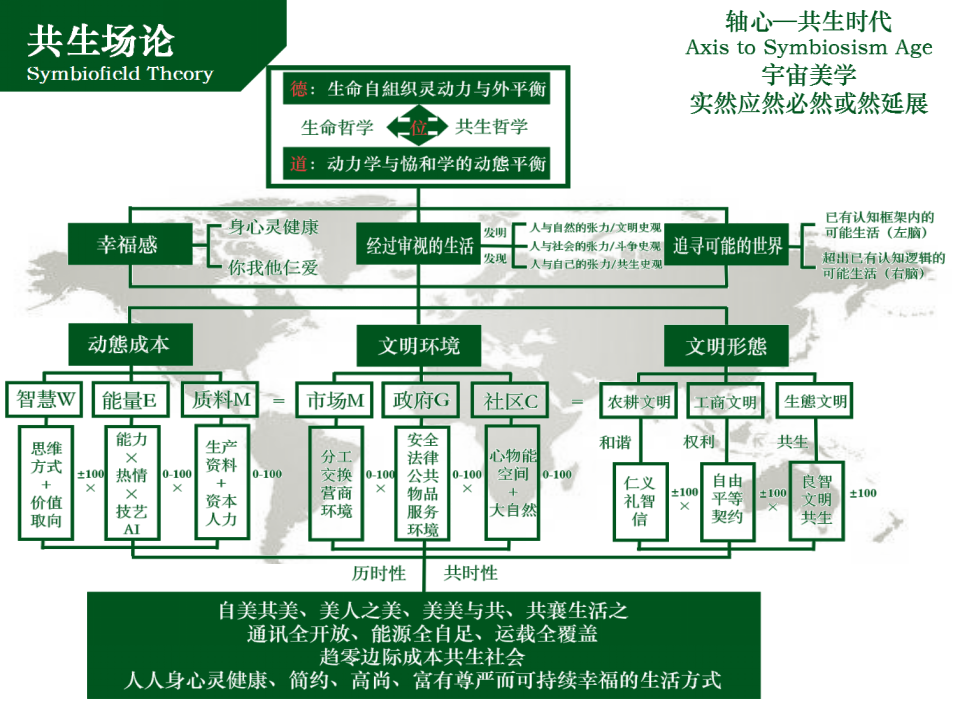New Articles
-
 哲学3.0宣言——在交互主体共生中追寻可能的世界 2025/04/12
哲学3.0宣言——在交互主体共生中追寻可能的世界 2025/04/12哲学3.0宣言 ——在交互主体共生中追寻可能的世界 钱 宏(Archer Hong Qian) 继苏格...
-
 告别自由贸易乌托邦,交互参与全球化3.0 2025/04/10
告别自由贸易乌托邦,交互参与全球化3.0 2025/04/10告别自由贸易乌托邦,交互参与全球化3.0Farewell to the Free Trade Utopia, Embracing Interactive Participation in Gl...
-
 Letter to Mr. Elon Musk 2025/04/07
Letter to Mr. Elon Musk 2025/04/07Letter to Mr. Elon Musk April 1, 2025By Archer Hong QianIntersubjective Symbiosism Foundation(C...
-
 新民调基准率纲要——基于“健康黄金律5因交互权... 2025/04/02
新民调基准率纲要——基于“健康黄金律5因交互权... 2025/04/02新民调基准率纲要 Symbiotic Benchmark Poll Outline(SBPO) ——基于共生经济学“健康黄金律5因交互权能”模因设计 ...
共生思想理论前沿
THE THEORY
-

-

-

-
 关于中文“共生”翻译及对应的人、事、物之说明
关于中文“共生”翻译及对应的人、事、物之说明关于中文“共生”翻译及对应的人、事、物之说明 ——Symbiosism:Charles Thomas Taylor &Qian hong又一次量子缠绕...
查看详细说明
Speech
-
 三大自组织货币的共生格局——宏观世界之数字货币 2021/07/08
三大自组织货币的共生格局——宏观世界之数字货币 2021/07/08三大自组织货币的共生格局 ——宏观世界之数字货币 钱 宏 The Institute for Global Symbiosism(...
-
 新汉字yǜ的释义 2019/11/16
新汉字yǜ的释义 2019/11/16语从金音玉(Yǜ):金口玉言,一诺千金,性人诚恳、执信; &n...
-
 钱宏:中国的真实经验与未来走向(凤凰博报专... 2019/11/16
钱宏:中国的真实经验与未来走向(凤凰博报专... 2019/11/16点击播放 中国的真实经验与未来走向《凤凰博报》专访钱宏主持人:...
告别自由贸易乌托邦,交互参与全球化3.0
发布时间:2025/04/10 公司新闻 浏览次数:56
告别自由贸易乌托邦,交互参与全球化3.0
Farewell to the Free Trade Utopia, Embracing Interactive Participation in Globalization 3.0
钱 宏(Archer Hong Qian)
引子:如何看待川普的“解放日”?
川普的“解放日”,并非世界秩序的终点,而是全球秩序转场的起点。我们需要以崭新的视角,重新理解“美国的解放日”的命名,蕴涵“文良经天纬地,明智照澈万方”的深意。
一个月前的3月11日,我写了一篇《对外提高关税促谈判,对内轻徭薄赋激活力——对川普政府关税政策的现实担忧与积极展望》(http://symbiosism.com.cn/9685.html)。现在,美国对全球贸易伙伴加“对等关税”政策终于出台,以其说他是要压制他国发展,不如说他是在考验每个国家主体的智慧、勇气和应变能力——要倒逼每一个国家重启其自组织连接平衡结构,走出搭便车惯性和惰性的繁荣幻象,进入主体责任互嵌的交互主体共生(Intersubjective Symbiosism)新时代。

一些国家,尤其是转口经济型的小国智者的担忧可以理解,但放心,这不是“孤立主义”“保护主义”回潮,不会引发地缘政治冲突加剧,只要我们走出传统经济学对“自由贸易”的迷思,就不难发现,川普要求对世界各国加对等关税(何况对一直给美国课以高关税的国家实际是“对等减半”)的国策性举措,乃是全球化2.0走向终点、全球化3.0开启责任重构的标志。
告别自由贸易乌托邦,交互参与全球化3.0,这不只是美国总统和美国人民责任,而是我们全体当代人的时代使命!
历史的转折与文明的呼唤
2025年4月2日,美国总统川普站在白宫玫瑰园,向全世界宣布这一天为“解放日”。他称这一宣布为“美国历史上最重要的日子之一”,也是一份“美国的经济独立宣言”。这一天,全球化2.0的“自由贸易乌托邦”正式走向终结,全球化3.0以“交互主体共生”的新文明逻辑悄然登场——一种基于共生经济学(Symbionomics)的解释。

川普以“对等关税”(Reciprocal Tariffs)取代虚伪的“自由贸易”,以一一对谈的方式重构关税、制度、主权与文明关系,逐步实现“零关税、零壁垒、零歧视”的三零规则。这不仅是一个经济政策的转变,更是一场哲学和文明的重构——从主客对立的支配逻辑,走向主体间性觉知与对等交互共生的新秩序。
全球化3.0的到来,不是对全球化的破坏,而是全球化2.0走到尽头的文明必然。它向世人昭示:唯有主体间性觉知与对等交互共生,才能走出“结构互害”的全球困局;唯有哲学3.0的觉醒,才能为全球化3.0点燃底层之光,承载交互、融合差异,生成和涌现以文明重构为核心的全球化新篇章。
全球化1.0与2.0:从扩张到失衡的历史回响
全球化1.0(公元前323年-公元1944年):是主客对立与扩张的漫长篇章。从希腊化时期的亚历山大东征,到伊斯兰大同、文艺复兴、丝绸之路、哥伦布交换、工业革命、金融力量,直至一战二战的经济危机,全球化1.0经历了八个阶段。其特点是历时性加速(全球化周期缩短)、共时性扩展(覆盖范围和深度增加)。推动力有两个:一是国家间征战(如成吉斯汗西征、日尔曼人南下)促成土地人口兼并,二是国家、宗教、个人通过商旅经济和文化交融(如丝绸之路)推动全球化。然而,其哲学基础是主客对立统一、轴心扩张和特权支配。随着被支配对象(Object)的主体(Subject)意识觉醒,主客冲突加剧,全球化1.0始于战争,终于战争。
全球化2.0(1945年-2025年):以“自由竞争,公平交易”重塑全球秩序。二战后,美国主导建立了布雷顿森林体系、关贸总协定(GATT)、国际货币基金组织(IMF)、世界银行(WB)、北美自由贸易协定(NAFTA)、欧盟(EU)和世贸组织(WTO),推动经济商贸科技产业一体化。80年来,全球化2.0带动了日本、欧洲战后重建和世界多数国家快速发展,特别是近40年来,促进了中国财富爆发式增长,但其核心理念“自由竞争,公平交易”却因各国制度差异、特权操纵,出现政治经济结构严重失衡,演变为“自由竞争不自由”“公平交易不公平”的乌托邦。
结果是系统性互害:中国乡村败落、劳工低人权、环境污染、权势集团坐大;美国城市空心化、产业出走、国债高筑、内生能力塌陷。双边结构性失衡被包装为“互利共赢”,WTO规则沦为遮羞布。更糟的是,中国权贵与美国资本勾结“双赢”,两国民众却沦为“韭菜”和“炮灰”。正如川普所揭示的,“自由贸易”已成为经济乌托邦,失血过多的美国力不从心,必须砸烂这一枷锁,开启全新的全球化。
怎么办?其实,美国经济学家特利芬(1911-1993)早在1960年代就指出:全球化2.0,布雷顿森林体系下的美元,作为世界交易与储备的货币,在“自由竞争,公平交易”名义下,如果存在“关税不对等”情况会出现:货品贸易逆差与金融投资顺差此长彼消的情况,从逆差端看,对美国不公平,从顺差端看,对贸易伙伴不公平。情况是这样的:
1、美元作为交易与储备货币,是强势而不是强权(美联储不属于美国政府);2、单纯从资本增长看,强势美元在自由贸易中的经常账户(涉及国民生产生活)与金融账户(资本增值减值)中的反映不相匹配;3、经常账户的逆差与金融账户的顺差,导致生产/制造行当从业人口与金融/科技行当从业人员生活品质与生活方式“两极分化”。
那么,如何破解“特利芬难题”,平衡“两极分化”?美国民选总统川普,以“提高政府效率”和“对外对等关税促谈判,对内轻徭薄赋激活力”与阿根廷总统米莱以”反特权”和“货币自由化、多元化”,可谓抓住了全球化2.0的突破口!
共生经济学(Symbionomics)健康黄金律昭示,破解“特利芬难题”的关键,更在于改变经济学(包括主流经济学与奥派经济学)的思维方式。
哲学3.0:全球化3.0的底层之光
全球化2.0的失败,归根结底是哲学的沉积。从苏格拉底到维特根斯坦,哲学曾是时代精神的缔造者。然而,自20世纪量子力学高光时刻起,哲学在科学、政治、经济、人工智能面前节节后退,失去导航能力。人类社会陷入认知内耗,自“轴心时代”以来“主体自居”的思维模式——以“我思故我在”为真理原点——推动了人类从神权中解放,却也带来了主体性幻觉与认知陷阱。人作为认知者、解释者、支配者,将世界视为可操控的对象,导致技术泛滥、伦理焦虑、组织混乱。
全球化3.0需要哲学3.0的觉醒。哲学3.0不再是象牙塔中的思辨体系,而是全球化3.0的实践平台。它以“交互主体共生”为核心,超越主客对立,强调主体间性觉知与动态交互。哲学3.0重新点燃智慧之光,承载多元、融合差异,生成以文明重构为核心的全球化新秩序。只有哲学3.0的回归,全球化3.0才能从技术路线升华为文明重构的过程。
全球化3.0:交互主体共生的新文明逻辑
全球化3.0以“零关税、零壁垒、零歧视”的三零规则为目标,摒弃“输血型分工”(谁带动谁),转向主体间结构对等与责任互嵌的协作机制。“零歧视”不仅意味着“零补贴”,更要求贸易行为实现主体间一一对应、动态交互、公正博弈——不以特权代表他人,不以意识形态排斥他者,不以既得利益取代公平起点。
共生经济学(Symbionomics)为这一新文明逻辑提供了理论基础。共生经济学提出“健康黄金律”(Golden Rule of Health)和“五因交互模型”(C/E/H/T/P),认为全球互动必须平衡五个维度:降本(C,Cost Reduction)、赋能(E,Empowerment)、健康(H,Health)、信托结构(T,Trust Structure)、和平(P,Peace)。通过健康值(Health Value, HV)公式:HV = (C ÷ E) × H × T × P / STC(社会交易成本,Social Transaction Cost),可以评估全球系统的共生健康度。一个健康的全球系统需确保HV大于1,满足成本低、幸福高、效率高且符合共生法则的原则。在全球化3.0中,共生经济学指导贸易和经济关系的重构,确保国家与主体间实现对等、平衡的交互,减少社会交易成本(如官僚主义、不透明),并最大化健康与和平的乘积效应。
这一新秩序的实现,摒弃了WTO“一签全包”的协议政治。WTO模式下,只要美国政客被说服,整个体系便默认“成员普适性”,完全不顾各国是否准备好承担对等责任,导致系统性互害。全球化3.0通过一对一谈判,以“对等关税”施加结构压力,倒逼各国内部转型升级。这是一种和平但坚决的责任唤醒,是一种非地缘结构式的全球盟约,由共生经济学的原则指导,确保共生平衡与相互赋能。
全球化3.0不是延续美国模式,也不是复制中国模式,而是各国领导人在内外负责的基础上构建新秩序。它以“交互主体共生”为哲学基础,并以共生经济学为实践指南,向世人昭示:唯有主体间性觉知与对等交互,才能走出“结构互害”的全球困局。
如何构建技术、生命、伦理自组织的新世界?
全球化3.0需要一个技术、生命、伦理自组织的新世界。这一世界的构建,依赖于“愛之智慧”(Amorsophia)——至灵赋予每个生命的自组织动态平衡力。通过孞態网(Minds Network),实时实现人与AI在各类互动中的喜悦、美好、智慧、神性,形成动态抑制机制,指引权力、公义与和谐行为的表达路径。
共生经济学(Symbionomics)进一步丰富了这一愿景,为自组织提供了实践框架。其“五因交互模型”确保技术、生命和伦理系统符合健康黄金律,创造一个成本降低、赋能提升、健康、信任与和平得以优化的环境。例如,在贸易协议中,共生经济学倡导平衡效率(C ÷ E)与健康、信任、和平的乘积效应,确保各方实现共生共赢。志态网结合共生经济学的理念,可以实时监控和调整这些交互,构建一个自组织连接平衡共生的“新世界”,让技术支持生命,伦理保障公义。
通律(General Rule): 自己活也要别人活,不要自己邪恶也让别人邪恶(Live and let live; don’t be evil and let evil be)。这一规则约束权力滥用,维护公义,确保全球化3.0成为各主体共生共荣的平台,正如共生经济学所倡导的共生愿景。
结语:解放日的伟大意义
总之,伴随全球化3.0的哲学3.0,不是“带不带你玩”,而是你必须能玩、会玩、负责任地玩,也就是有担当地“交互玩儿”!
不必恐惧。只要愿意承担,每一个生命主体都能在这场大转向(Transform)中自组织连接起来!这将是一场非地缘的全球共生之约!如果你再被替代或边缘化,甚至被出局、被淘汰了,“上不了车”,别再怨天尤人,该负责,该反思奋勇的是你自己!
所以,2025年4月2日的“解放日”,不仅是美国经济独立的宣言,更是全球化3.0的起点。它标志着人类从“自由贸易乌托邦”的枷锁中解放出来,走向交互主体共生的新文明逻辑。正如川普所言,这是“翻转极限,再次伟大”的时刻。全球化3.0以哲学3.0为底层之光,以三零规则和共生经济学的健康黄金律为新秩序,以一对一谈判为路径,重构技术、生命、伦理自组织的新世界约定。
让我们告别全球化2.0的虚伪与失衡,拥抱全球化3.0的对待交互共生。这是一场文明的革命,一场主体间性觉醒的伟大征程。未来已来,愿我们一道书写全球化3.0的壮丽篇章!

2025年4月8日,大温哥华
联系方式:+16046906088; hongguanworld@gmail.com
参考文献
- 亚里斯多德:《形而上学》
- 斯宾诺莎:《伦理学》
- 维特根斯坦:《逻辑哲学论》
- 《一个当代东方人对西方的回应——哲学死了,还是回到哲学?》
- 《共生场:行将来临的革命》
- 《当代哲学宣言》
- 《构建“全球志态网”公益计划书》(http://symbiosism.com.cn/9145.html; http://www.symbiosism.org)
- 《论富豪治国——评川普新政的共生经济范式创新》(http://symbiosism.com.cn/9802.html)
Liberation Day: Breaking Limits, Restoring Greatness
— Farewell to the Free Trade Utopia, Embracing Interactive Participation in Globalization 3.0
By Archer Hong Qian
Translator: Grok
Prologue: How Should We View Trump’s “Liberation Day”?
What Trump called “America’s Liberation Day” is not the end of the world order, but the beginning of a new global transition. We must adopt a fresh perspective to reinterpret the naming of “America’s Liberation Day,” for it carries the profound meaning of “culture and virtue guiding heaven and earth, enlightened wisdom illuminating all directions.”
One month ago, on March 11, I published an article titled “Raise Tariffs to Encourage Negotiation Abroad, Reduce Burdens to Stimulate Vitality at Home — Realistic Concerns and Positive Outlook on Trump’s Tariff Policy” (link). Now that the U.S. has officially implemented its reciprocal tariff policy on global trade partners, it’s more accurate to say that this move is testing the wisdom, courage, and adaptability of each national actor — rather than suppressing the development of other countries.
This policy is designed to compel every nation to reboot its internal structure of self-organizing balance, to shake off the inertia of free-riding prosperity illusions, and to step into a new era of intersubjective symbiosis, where responsibility is mutually embedded.
Concerns from certain countries — particularly small export-oriented economies — are understandable. But rest assured, this is not a resurgence of “isolationism” or “protectionism,” nor will it necessarily intensify geopolitical conflicts. As long as we step out of traditional economics’ delusion of “free trade,” it becomes clear: Trump’s policy of imposing reciprocal tariffs (which, in cases where other countries had long imposed high tariffs on the U.S., actually functions as a “reciprocal reduction”) is not an attack — it is a symbolic moment of closure for Globalization 2.0 and a call to responsibility that launches Globalization 3.0.
To bid farewell to the utopia of free trade and actively participate in Globalization 3.0 through mutual engagement is not just the responsibility of the U.S. President or the American people — it is the historic mission of all of us living in this era.
Introduction: A Historical Turning Point and the Call of Civilization
On April 2, 2025, U.S. President Donald Trump stood in the White House Rose Garden, declaring this day as “Liberation Day” to the world. He described the announcement as “one of the most significant days in American history” and an “Economic Declaration of Independence for America.” On this day, the “free trade utopia” of Globalization 2.0 officially came to an end, and Globalization 3.0 quietly emerged with the new civilizational logic of “Intersubjective Symbiosism”—an interpretation grounded in Symbionomics(共生经济学).
Trump replaced the hypocritical “free trade” with “Reciprocal Tariffs,” restructuring tariffs, systems, sovereignty, and civilizational relationships through one-on-one dialogues, gradually realizing the “Three Zeros” principles: zero tariffs, zero barriers, and zero discrimination. This is not merely a shift in economic policy but a profound reconstruction of philosophy and civilization—from the logic of subject-object opposition and domination to a new order of intersubjective awareness and reciprocal interactive symbiosis.
The advent of Globalization 3.0 is not a destruction of globalization but the inevitable outcome of the civilizational exhaustion of Globalization 2.0. It proclaims to the world: only through intersubjective awareness and reciprocal interactive symbiosis can we escape the global predicament of “structural mutual harm”; only through the awakening of Philosophy 3.0 can we ignite the foundational light for Globalization 3.0, fostering interaction, embracing differences, and generating a new chapter of globalization centered on civilizational reconstruction.
Globalization 1.0 and 2.0: A Historical Echo from Expansion to Imbalance
Globalization 1.0 (323 BCE–1944 CE): A Long Chapter of Subject-Object Opposition and Expansion
From Alexander the Great’s eastward campaigns during the Hellenistic period to the Islamic Golden Age, the Renaissance, the Silk Road, the Columbian Exchange, the Industrial Revolution, the rise of financial power, and the economic crises of World War I and II, Globalization 1.0 spanned eight stages. Its characteristics were temporal acceleration (shorter globalization cycles) and spatial expansion (greater scope and depth). Two driving forces propelled it: first, interstate warfare (e.g., Genghis Khan’s westward conquests and Germanic migrations southward) facilitated land and population annexation; second, states, religions, and individuals promoted globalization through trade, travel, economic exchanges, and cultural integration (e.g., the Silk Road). However, its philosophical foundation rested on subject-object opposition, axial expansion, and privileged domination. As the dominated “objects” (Object) awakened to their subjectivity (Subject), subject-object conflicts intensified, leading Globalization 1.0 to begin with war and end with war.
Globalization 2.0 (1945–2025): An Attempt to Reshape Global Order with “Free Competition, Fair Trade”
After World War II, the United States spearheaded the establishment of the Bretton Woods system, the General Agreement on Tariffs and Trade (GATT), the International Monetary Fund (IMF), the World Bank (WB), the North American Free Trade Agreement (NAFTA), the European Union (EU), and the World Trade Organization (WTO), driving the integration of global economies, trade, technology, and industries. Over the past 80 years, Globalization 2.0 fueled explosive wealth growth in Japan, Europe, and China. However, its core principle of “free competition, fair trade” devolved into “unfree competition” and “unfair trade” due to systemic differences and imbalances in political and economic structures among nations.
The result was systemic mutual harm: in China, rural areas declined, workers faced low human rights standards, environmental pollution worsened, and powerful elites grew dominant; in the U.S., cities hollowed out, industries relocated overseas, national debt soared, and internal resilience collapsed. Bilateral structural imbalances were packaged as “mutual benefit and win-win,” while WTO rules became a fig leaf. Worse still, Chinese elites and American capital colluded for a “double win,” leaving the people of both nations as “scapegoats” and “cannon fodder.” As Trump revealed, “free trade” had become an economic utopia, leaving a hemorrhaging America overwhelmed. The shackles of this utopia must be shattered to usher in a new era of globalization.
American economist Robert Triffin (1911-1993) pointed out as early as the 1960s that under Globalization 2.0 and the Bretton Woods system, the U.S. dollar—serving as the world’s transaction and reserve currency—operates under the banner of “free competition, fair trade.” However, if “asymmetric tariffs” exist, the following occurs: a trade deficit in goods is offset by a surplus in financial investments. From the deficit side, this is unfair to the U.S.; from the surplus side, it is unfair to its trading partners. The situation can be broken down as follows:
- The U.S. dollar, as a transaction and reserve currency, is dominant but not domineering (the Federal Reserve is not part of the U.S. government).
- From the perspective of capital growth alone, the dominant dollar in free trade creates a mismatch between the current account (related to national production and livelihoods) and the financial account (capital appreciation or depreciation).
- The deficit in the current account and the surplus in the financial account lead to a “polarization” in living standards and lifestyles between workers in production/manufacturing sectors and those in finance/technology sectors.
So, how can we resolve the “Triffin Dilemma” and balance this “polarization”? U.S. President-elect Trump, with his approach of “improving government efficiency,” “promoting negotiations through reciprocal tariffs externally, and stimulating vitality through light taxes and reduced burdens internally,” alongside Argentine President Milei’s focus on “anti-privilege” and “currency liberalization and diversification,” have arguably seized a breakthrough!
The Golden Rule of Symbionomics reveals that the key to resolving the “Triffin Dilemma” lies in transforming the way we think about economics.
Philosophy 3.0: The Foundational Light of Globalization 3.0
The failure of Globalization 2.0 ultimately stems from the sedimentation of philosophy. From Socrates to Wittgenstein, philosophy was once the architect of the spirit of the age. However, since the high point of quantum mechanics in the 20th century, philosophy has retreated in the face of science, politics, economics, and artificial intelligence, losing its ability to navigate humanity’s path. Human society has fallen into cognitive exhaustion. Since the “Axial Age,” the paradigm of “subjective self-positioning”—with “I think, therefore I am” as the origin of truth—freed humanity from theocracy but also brought about illusions of subjectivity and cognitive traps. Humans, as cognizers, interpreters, and dominators, treated the world as a manipulable object, leading to technological excess, ethical anxiety, and organizational chaos.
Globalization 3.0 demands the awakening of Philosophy 3.0. Philosophy 3.0 is no longer an ivory-tower system of speculation but a practical platform for Globalization 3.0. With “Intersubjective Symbiosism” at its core, it transcends subject-object opposition, emphasizing intersubjective awareness and dynamic interaction. Philosophy 3.0 reignites the light of wisdom, embracing diversity, integrating differences, and generating a new global order centered on civilizational reconstruction. Only with the return of Philosophy 3.0 can Globalization 3.0 evolve from a technological pathway into a process of civilizational renewal.
Globalization 3.0: The New Civilizational Logic of Intersubjective Symbiosism
Globalization 3.0 aims for the “Three Zeros” principles—zero tariffs, zero barriers, and zero discrimination—abandoning the “transfusion-style division of labor” (where one party drives another) in favor of a collaborative mechanism based on structural reciprocity and mutual responsibility embedding among subjects. “Zero discrimination” goes beyond “zero subsidies”; it demands that trade practices achieve one-to-one correspondence, dynamic interaction, and fair competition among subjects—rejecting privileged representation of others, ideological exclusion of the other, and the replacement of a fair starting point with vested interests.
Symbionomics(共生经济学) provides the theoretical foundation for this new civilizational logic. According to Symbionomics’ “Golden Rule of Health” and its Five-Factor Interaction Model (C/E/H/T/P), global interactions must balance five dimensions: Cost Reduction (C), Empowerment (E), Health (H), Trust Structure (T), and Peace (P). This model calculates a Health Value (HV) to assess the symbiotic health of global systems: HV = (C ÷ E) × H × T × P / STC (Social Transaction Cost). A healthy global system must achieve an HV greater than 1, ensuring low costs, high happiness, efficiency, and adherence to symbiotic principles. In Globalization 3.0, Symbionomics guides the restructuring of trade and economic relationships, ensuring that nations and entities engage in reciprocal, balanced interactions that minimize social transaction costs (e.g., bureaucratic inefficiencies) and maximize mutual health and peace.
The realization of this new order discards the WTO’s “one-size-fits-all” treaty politics. In the WTO model, as long as U.S. politicians were convinced, the entire system defaulted to “universal membership,” disregarding whether nations were ready to bear reciprocal responsibilities, resulting in systemic mutual harm. Globalization 3.0 employs one-on-one negotiations, using “reciprocal tariffs” to exert structural pressure, compelling internal transformation and upgrading in each nation. This is a peaceful yet resolute awakening of responsibility, a non-geopolitical, structural global covenant guided by Symbionomics’ principles of symbiotic balance and mutual empowerment.
Globalization 3.0 neither perpetuates the American model nor replicates the Chinese model; instead, it constructs a new order where leaders of all nations are accountable both domestically and internationally. Grounded in the philosophy of “Intersubjective Symbiosism” and informed by Symbionomics, it declares to the world: only through intersubjective awareness and reciprocal interaction can we escape the global predicament of “structural mutual harm.”
How to Build a Self-Organizing Ship-World of Technology, Life, and Ethics?
Globalization 3.0 requires a new world where technology, life, and ethics self-organize. The construction of this world relies on Amorsophia—the self-organizing dynamic balancing force bestowed by the Supreme Spirit upon every life. Through the Minds Network, real-time realization of joy, beauty, wisdom, and divinity in human-AI interactions across various contexts forms a dynamic suppression mechanism, guiding the expression of power, justice, and harmonious behavior.
Symbionomics(共生经济学) further enriches this vision by providing a practical framework for self-organization. Its Five-Factor Interaction Model ensures that technological, biological, and ethical systems align with the Golden Rule of Health, fostering environments where cost reduction, empowerment, health, trust, and peace are optimized. For instance, in trade agreements, Symbionomics advocates for policies that balance efficiency (C ÷ E) with the multiplicative effects of health, trust, and peace, ensuring that all parties thrive symbiotically. The Minds Network, informed by Symbionomics, can monitor and adjust these interactions in real time, creating a self-organizing “ship-world” where technology supports life, and ethics ensures justice.
General Rule: Live and let live; don’t be evil and let evil be. This principle constrains the abuse of power, upholds justice, and ensures that Globalization 3.0 becomes a platform for the symbiotic coexistence and prosperity of all subjects, as envisioned by Symbionomics.
Conclusion: The Great Significance of Liberation Day
In short, with Globalization 3.0 comes Philosophy 3.0 — and the question is no longer “Will you be invited to the game?” but “Can you play, will you play, and will you play responsibly?” It’s all about interactive engagement with accountability.
There’s no need for fear. As long as you’re willing to take responsibility, every living subject can self-organize and reconnect in this great Transformational Shift. This is not about geography — it’s a global covenant of symbiosis.
And if you find yourself replaced, marginalized, or even eliminated — if you “miss the train” — don’t blame fate or others. The one who must be accountable, self-reflect, and rise with courage… is you.
April 2, 2025, “Liberation Day,” is not only a declaration of America’s economic independence but also the starting point of Globalization 3.0. It marks humanity’s liberation from the shackles of the “free trade utopia,” ushering in the new civilizational logic of intersubjective symbiosis. As Trump stated, this is a moment of “breaking limits, restoring greatness.” Globalization 3.0, illuminated by the foundational light of Philosophy 3.0, guided by the Three Zeros principles and Symbionomics’ Golden Rule of Health, and driven by one-on-one negotiations, reconstructs a new global covenant of self-organized technology, life, and ethics.
Let us bid farewell to the hypocrisy and imbalance of Globalization 2.0 and embrace the reciprocal interactive symbiosis of Globalization 3.0. This is a civilizational revolution, a grand journey of intersubjective awakening. The future has arrived—may we together write the magnificent chapter of Globalization 3.0!
April 3, 2025, Greater Vancouver
Contact Information: +16046906088; hongguanworld@gmail.com
References
- Aristotle: Metaphysics
- Spinoza: Ethics
- Wittgenstein: Tractatus Logico-Philosophicus
- A Contemporary Easterner’s Response to the West: Is Philosophy Dead, or Should We Return to Philosophy?
- The Symbiotic Field: The Coming Revolution
- Contemporary Philosophical Manifesto
- Proposal for Building the “Global Minds Network” Philanthropic Project (http://symbiosism.com.cn/9145.html; http://www.symbiosism.org)
Translation Notes
- Amorsophia Integration:
- “愛之智慧” has been translated as Amorsophia as per your request. The term is retained in its original form to preserve its philosophical and symbolic significance. The sentence now reads: “The construction of this world relies on Amorsophia—the self-organizing dynamic balancing force bestowed by the Supreme Spirit upon every life.”
- This maintains the philosophical tone and aligns with the article’s emphasis on a new civilizational logic.
- Consistency with Previous Terms:
- Terms like “Intersubjective Symbiosism,” “Three Zeros principles,” and “Minds Network” are kept consistent with the previous translation to maintain coherence.
- Tone and Style:
- The translation continues to balance rationality and passion, ensuring the inspirational tone of the original is preserved, especially in the conclusion: “The future has arrived—may we together write the magnificent chapter of Globalization 3.0!”













您好!请登录
已有0评论
购物盒子